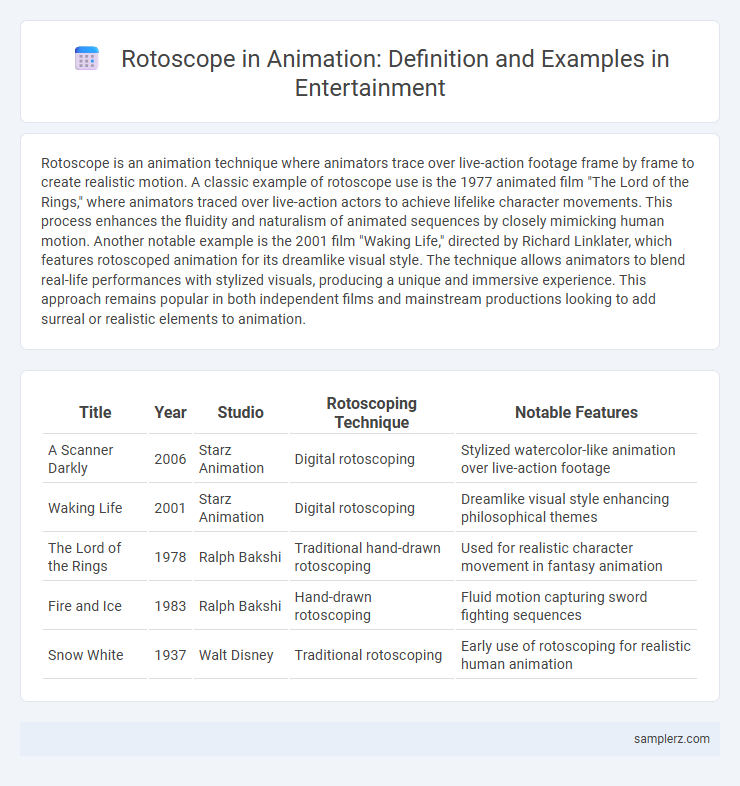Rotoscope is an animation technique where animators trace over live-action footage frame by frame to create realistic motion. A classic example of rotoscope use is the 1977 animated film "The Lord of the Rings," where animators traced over live-action actors to achieve lifelike character movements. This process enhances the fluidity and naturalism of animated sequences by closely mimicking human motion. Another notable example is the 2001 film "Waking Life," directed by Richard Linklater, which features rotoscoped animation for its dreamlike visual style. The technique allows animators to blend real-life performances with stylized visuals, producing a unique and immersive experience. This approach remains popular in both independent films and mainstream productions looking to add surreal or realistic elements to animation.
Table of Comparison
| Title | Year | Studio | Rotoscoping Technique | Notable Features |
|---|---|---|---|---|
| A Scanner Darkly | 2006 | Starz Animation | Digital rotoscoping | Stylized watercolor-like animation over live-action footage |
| Waking Life | 2001 | Starz Animation | Digital rotoscoping | Dreamlike visual style enhancing philosophical themes |
| The Lord of the Rings | 1978 | Ralph Bakshi | Traditional hand-drawn rotoscoping | Used for realistic character movement in fantasy animation |
| Fire and Ice | 1983 | Ralph Bakshi | Hand-drawn rotoscoping | Fluid motion capturing sword fighting sequences |
| Snow White | 1937 | Walt Disney | Traditional rotoscoping | Early use of rotoscoping for realistic human animation |
Defining Rotoscope in Animation
Rotoscope in animation is a technique where animators trace over live-action footage frame by frame to create realistic movement and lifelike character motion. This method enhances fluidity and detail, evident in films like "A Scanner Darkly" and classic Disney productions such as "Snow White and the Seven Dwarfs." By capturing the nuances of real performances, rotoscoping bridges the gap between live-action and animated storytelling.
Early Pioneers of Rotoscoping
Rotoscoping was pioneered by Max Fleischer in the 1910s, who invented the technique to trace live-action film frame-by-frame for realistic animation. Early examples include Fleischer's Out of the Inkwell series, where characters like Koko the Clown blended live-action dynamics with hand-drawn elements. This innovation laid the foundation for future animation studios to enhance motion accuracy and visual storytelling using rotoscope technology.
Classic Films Utilizing Rotoscope
Classic films like "Snow White and the Seven Dwarfs" (1937) and "Sleeping Beauty" (1959) exemplify early use of rotoscope animation to achieve realistic human movements. Max Fleischer's "Gulliver's Travels" (1939) also showcased rotoscoping to blend live-action precision with hand-drawn animation. These pioneering techniques set the foundation for modern animators to create lifelike character motion while maintaining artistic expression.
Rotoscope in Animated TV Series
Rotoscope technique in animated TV series enhances realism by tracing live-action footage frame-by-frame, creating smooth, lifelike character movements. Notable examples include "Undone," which uses rotoscoping to blend psychological storytelling with visually dynamic animation. This method allows for detailed facial expressions and fluid motion, elevating narrative depth in animated storytelling.
Iconic Music Videos Featuring Rotoscoping
Iconic music videos featuring rotoscoping include A-ha's "Take On Me," which blends pencil-sketch animation with live-action footage through meticulous frame-by-frame tracing. Peter Gabriel's "Sledgehammer" also utilizes rotoscoping to create surreal, animated sequences that enhance its innovative visual appeal. These examples showcase rotoscoping's ability to merge realistic motion with creative artistry, elevating storytelling in music videos.
Rotoscoping in Modern Feature Animation
Rotoscoping in modern feature animation enhances realism by tracing over live-action footage to create fluid, lifelike movements, as seen in films like "A Scanner Darkly" and "The Jungle Book" (2016). Advanced digital rotoscoping tools allow animators to blend traditional techniques with CGI, resulting in seamless character animations that maintain expressive detail. This method streamlines production workflows while preserving the artistry essential to emotionally engaging storytelling.
Advantages of Rotoscope Technique
Rotoscope animation enables animators to create highly realistic movements by tracing over live-action footage frame by frame, resulting in smoother character motions and enhanced visual authenticity. This technique significantly reduces production time compared to traditional hand-drawn animation while maintaining precise anatomical accuracy. Major animated films like "A Scanner Darkly" and "The Lord of the Rings" incorporated rotoscoping to achieve lifelike effects that resonate with audiences.
Challenges Faced in Rotoscoping Animation
Rotoscoping animation requires meticulously tracing live-action footage frame by frame, posing significant challenges in maintaining consistent character motion and fluidity. The technique demands high precision to avoid unnatural movements and time-consuming adjustments in complex scenes with intricate backgrounds. Artists often struggle with balancing detail preservation and stylization, which can affect the final animation's visual coherence and storytelling impact.
Digital Evolution of Rotoscoping
Digital evolution of rotoscoping revolutionized animation by integrating computer software, enabling precise frame-by-frame tracing with enhanced efficiency and flexibility. Modern tools like Adobe After Effects and Toon Boom Harmony allow animators to blend traditional hand-drawn techniques with digital workflows, producing smoother motion and complex visual effects. This advancement accelerated production timelines and expanded creative possibilities, shaping contemporary animated storytelling.
Rotoscoping’s Influence on Animation Style
Rotoscoping revolutionized animation by enabling artists to trace live-action footage for more realistic character movements, as seen in classics like "Snow White and the Seven Dwarfs" and modern films like "A Scanner Darkly." This technique enhanced fluidity and lifelike motion, blending traditional drawing with photographic precision to create a distinctive visual style. Its influence persists in contemporary animation and visual effects, where rotoscoping contributes to stylistic diversity and dynamic storytelling.

example of rotoscope in animation Infographic
 samplerz.com
samplerz.com